Essential Guide for Service Dog Handlers
Discover the essential knowledge and responsibilities of service dog handlers. This overview covers service dog requirements, laws, and key considerations for effective handling.
BEGINNER BASICS
1/3/20252 min read


Why Knowing the Laws Matters
Understanding the laws surrounding service dogs is essential for both handlers and the public. For handlers, it’s about knowing when you’re protected and how to advocate for yourself and your dog. For others, it’s about respecting those rights and avoiding unintentional discrimination. Imagine being told you can’t bring your service dog into a store because the staff doesn’t understand the law—like a handler being denied entry to a restaurant because their service dog is mistaken for a pet. Knowing the law ensures you can advocate for your rights in such situations.
What Service Dogs Can Legally Do
Service dogs are protected under several federal laws that ensure they can accompany their handlers in various settings:
Americans with Disabilities Act (ADA): Grants access to public spaces like restaurants, stores, and transportation.
Fair Housing Act (FHA): Protects service dog handlers in housing, even in places with “no pets” policies.
Air Carrier Access Act (ACAA): Allows service dogs to fly with their handlers.
These laws ensure that service dogs can perform their tasks without interference. For more details, check out my Federal Guidelines post.
What Handlers Need to Know
As a handler, you also have responsibilities. These include:
Complying with Local Dog Laws: This means keeping your dog vaccinated, adhering to leash laws (unless your dog needs to work off-leash), and cleaning up after them.
Maintaining Control: If your dog works off-leash, they must be under voice or signal control at all times.
Answering Questions: You’re not required to show paperwork or an ID. Businesses can only ask two questions: 1) Is the dog a service animal required because of a disability? and 2) What task or work has the dog been trained to perform?
When I’ve been asked these questions, I respond with short, confident answers, such as stating the task my dog performs or clarifying their role. This approach often clears up confusion quickly and avoids unnecessary debates.
Common Misconceptions About Service Dogs
There’s a lot of misinformation out there about service dogs. Here are some common myths:
Vests are Required: They’re not, though they can make interactions smoother.
Service Dogs Must Be Registered: There is no federally recognized service dog registry. However, airlines assign a lifetime Service Animal ID for flying.
Emotional Support Animals (ESAs) Are Service Dogs: ESAs have fewer rights than service dogs but more than pets. For example, ESAs are not granted public access under the ADA.
For a deeper dive into these misconceptions, check out my Myths or Misconceptions post.
Resources for Handlers
Educating yourself is the first step to becoming a confident handler. Here are some resources to explore:
The ADA website provides detailed information on your rights.
My blog’s resource page lists multiple service dog related resources.
Browse other posts here for more insights and tips.
Wrap-Up: Navigating Legal Challenges Together
The laws protecting service dogs are powerful, but the lack of public awareness can make things challenging for handlers. It’s up to us to educate ourselves and others. By knowing the laws, you’ll not only advocate for yourself but also help pave the way for other handlers.
Take the next step: educate yourself further, read more of the blog, and share this knowledge with others. Together, we can spread awareness and make the world a more accessible place for service dog teams.
photo credit: krista269 on pixabay
